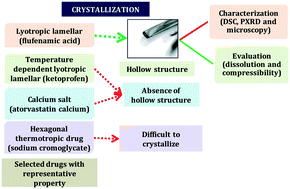Hollow crystal generation through polymorphic transformation – a case study of flufenamic acid†
Abstract
The present study was conducted to understand the mechanism behind the generation of hollow crystals. To validate the hypothesis that lamellar-structure-forming ability of a drug may contribute to hollow crystal formation, four different drugs, flufenamic acid (lyotropic lamellar), ketoprofen (temperature-dependent lyotropic lamellar), atorvastatin calcium (a calcium salt) and sodium cromoglycate (thermotropic hexagonal), were selected for the study. Crystallization results were in agreement with the hypothesis that drugs with lamellar properties (in this case flufenamic acid) are capable of forming hollow crystals. An ethanol/ethyl acetate-based solvent system allowed formation of hollow crystals of flufenamic acid, which was confirmed by optical microscopy. Flufenamic acid underwent polymorphic transformation from form I to form III during hollow crystal formation, which was confirmed by differential scanning calorimetry and powder X-ray diffraction. Polymorphic form III without hollow structure was generated to compare and evaluate the contribution of the newly generated habit to improvement of pharmaceutical attributes. Study of the dissolution of the hollow crystals showed a higher dissolution rate compared with plain flufenamic acid (form I) and polymorphic form III without hollow structure, which was attributed to the higher surface area of the hollow crystals. Similarly, at all studied compression pressures, compacted tablets of the hollow crystals demonstrated greater hardness than both plain flufenamic acid and crystals without hollow structure. In conclusion, this study is in agreement with the hypothesis that lamellar liquid crystalline drugs may possess an ability to form hollow crystals, and by virtue of their higher surface area, hollow crystals can improve pharmaceutical attributes like dissolution and compressibility.



 Please wait while we load your content...
Please wait while we load your content...